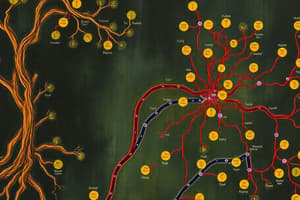Podcast
Questions and Answers
What occurs during the energy investment phase of glycolysis?
What occurs during the energy investment phase of glycolysis?
- Fructose-1,6-bisphosphate is produced without energy consumption.
- Glucose is converted to pyruvate with net ATP production.
- NADH is generated from glyceraldehyde-3-phosphate.
- Two molecules of ATP are consumed to convert glucose to fructose-1,6-bisphosphate. (correct)
Which of the following correctly describes the key regulatory enzymes in glycolysis?
Which of the following correctly describes the key regulatory enzymes in glycolysis?
- Phosphofructokinase-1 is inhibited by ATP and activated by AMP. (correct)
- Hexokinase is activated by glucose-6-phosphate.
- Phosphofructokinase-1 is activated by ATP and inhibited by AMP.
- Pyruvate kinase is inhibited by fructose-1,6-bisphosphate.
What is the net gain of glycolysis in terms of ATP and NADH production?
What is the net gain of glycolysis in terms of ATP and NADH production?
- 4 ATP and 4 NADH
- 2 ATP and 2 NADH (correct)
- 2 ATP and 4 NADH
- 4 ATP and 2 NADH
In the absence of oxygen, how does pyruvate typically convert in animals?
In the absence of oxygen, how does pyruvate typically convert in animals?
Which enzyme is responsible for the conversion of glyceraldehyde-3-phosphate to NADH?
Which enzyme is responsible for the conversion of glyceraldehyde-3-phosphate to NADH?
What are the end products of glycolysis?
What are the end products of glycolysis?
Flashcards are hidden until you start studying
Study Notes
Glycolysis Overview
- Definition: Glycolysis is a metabolic pathway that converts glucose into pyruvate, generating energy in the form of ATP and NADH.
- Location: Occurs in the cytoplasm of cells.
Phases of Glycolysis
-
Energy Investment Phase:
- Consumes energy (2 ATP).
- Converts glucose to fructose-1,6-bisphosphate.
- Key enzymes:
- Hexokinase (glucose to glucose-6-phosphate)
- Phosphofructokinase-1 (fructose-6-phosphate to fructose-1,6-bisphosphate).
-
Energy Payoff Phase:
- Produces energy (4 ATP, 2 NADH).
- Converts glyceraldehyde-3-phosphate to pyruvate.
- Key enzymes:
- Glyceraldehyde-3-phosphate dehydrogenase (produces NADH)
- Pyruvate kinase (produces ATP and pyruvate).
Key Products
- Net Gain:
- 2 ATP (4 produced - 2 used)
- 2 NADH
- 2 Pyruvate molecules.
Regulation
- Key Regulatory Enzymes:
- Hexokinase: inhibited by glucose-6-phosphate.
- Phosphofructokinase-1: regulated by ATP (inhibition) and AMP (activation).
- Pyruvate kinase: activated by fructose-1,6-bisphosphate.
Importance
- Central pathway in cellular respiration.
- Provides substrates for further energy production in aerobic and anaerobic conditions.
- Plays a crucial role in metabolism and energy balance.
Anaerobic Fate of Pyruvate
- In absence of oxygen:
- Conversion to lactate (in animals) or ethanol and CO2 (in yeast).
Summary
- Glycolysis is a fundamental biochemical pathway for energy production, involving a series of enzymatic reactions that convert glucose into pyruvate while generating ATP and NADH.
Glycolysis Overview
- Glycolysis is a metabolic pathway transforming glucose into pyruvate while generating ATP and NADH.
- The entire process takes place in the cytoplasm of cells.
Phases of Glycolysis
-
Energy Investment Phase:
- Consumes 2 ATP molecules to initiate glucose conversion.
- Converts glucose to fructose-1,6-bisphosphate.
- Key enzymes include:
- Hexokinase: converts glucose to glucose-6-phosphate.
- Phosphofructokinase-1: converts fructose-6-phosphate to fructose-1,6-bisphosphate.
-
Energy Payoff Phase:
- Produces 4 ATP and 2 NADH by converting glyceraldehyde-3-phosphate to pyruvate.
- Key enzymes include:
- Glyceraldehyde-3-phosphate dehydrogenase: produces NADH.
- Pyruvate kinase: generates ATP and converts phosphoenolpyruvate to pyruvate.
Key Products
- Net Gain:
- 2 ATP (4 produced minus 2 used).
- 2 NADH molecules.
- 2 pyruvate molecules are produced.
Regulation
- Key Regulatory Enzymes:
- Hexokinase: inhibited by glucose-6-phosphate to prevent excess glucose utilization.
- Phosphofructokinase-1: inhibited by ATP (indicating high energy) and activated by AMP (indicating low energy).
- Pyruvate kinase: activated by fructose-1,6-bisphosphate to enhance glycolytic flux.
Importance
- Glycolysis serves as a central pathway in cellular respiration.
- It provides essential substrates for energy production under both aerobic and anaerobic conditions.
- Plays a vital role in overall metabolism and maintaining energy balance in cells.
Anaerobic Fate of Pyruvate
- In the absence of oxygen, pyruvate can be converted to:
- Lactate in animal cells.
- Ethanol and carbon dioxide in yeast.
Studying That Suits You
Use AI to generate personalized quizzes and flashcards to suit your learning preferences.




